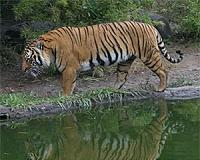 |
Paris (AFP) March 2, 2011 Mankind may have unleashed the sixth known mass extinction in Earth's history, according to a paper released on Wednesday by the science journal Nature. Over the past 540 million years, five mega-wipeouts of species have occurred through naturally-induced events. But the new threat is man-made, inflicted by habitation loss, over-hunting, over-fishing, the spread of germs and viruses and introduced species and by climate change caused by fossil-fuel greenhouse gases, says the study. Evidence from fossils suggests that in the "Big Five" extinctions, at least 75 percent of all animal species were destroyed. Palaeobiologists at the University of California at Berkeley looked at the state of biodiversity today, using the world's mammal species as a barometer. Until mankind's big expansion some 500 years ago, mammal extinctions were very rare: on average, just two species died out every million years. But in the last five centuries, at least 80 out of 5,570 mammal species have bitten the dust, providing a clear warning of the peril to biodiversity. "It looks like modern extinction rates resemble mass extinction rates, even after setting a high bar for defining 'mass extinction," said researcher Anthony Barnosky. This picture is supported by the outlook for mammals in the "critically endangered" and "currently threatened" categories of the Red List of biodiversity compiled by the International Union for Conservation of Nature (IUCN). On the assumption that these species are wiped out and biodiversity loss continues unchecked, "the sixth mass extinction could arrive within as little as three to 22 centuries," said Barnosky. Compared with nearly all the previous extinctions this would be fast-track. Four of the "Big Five" events unfolded on scales estimated at hundreds of thousands to millions of years, inflicted in the main by naturally-caused global warming or cooling. The most abrupt extinction came at the end of the Cretaceous, some 65 million years ago when a comet or asteroid slammed into the Yucatan peninsula, in modern-day Mexico, causing firestorms whose dust cooled the planet. An estimated 76 percent of species were killed, including the dinosaurs. The authors admitted to weaknesses in the study. They acknowledged that the fossil record is far from complete, that mammals provide an imperfect benchmark of Earth's biodiversity and further work is needed to confirm their suspicions. But they described their estimates as conservative and warned a large-scale extinction would have an impact on a timescale beyond human imagining. "Recovery of biodiversity will not occur on any timeframe meaningful to people," said the study. "Evolution of new species typically takes at least hundreds of thousands of years, and recovery from mass extinction episodes probably occurs on timescales encompassing millions of years." Even so, they stressed, there is room for hope. "So far, only one to two percent of all species have gone gone extinct in the groups we can look at clearly, so by those numbers, it looks like we are not far down the road to extinction. We still have a lot of Earth's biota to save," Barnosky said. Even so, "it's very important to devote resources and legislation toward species conservation if we don't want to be the species whose activity caused a mass extinction." Asked for an independent comment, French biologist Gilles Boeuf, president of the Museum of Natural History in Paris, said the question of a new extinction was first raised in 2002. So far, scientists have identified 1.9 million species, and between 16,000 and 18,000 new ones, essentially microscopic, are documented each year. "At this rate, it will take us a thousand years to record all of Earth's biodiversity, which is probably between 15 and 30 million species" said Boeuf. "But at the rate things are going, by the end of this century, we may well have wiped out half of them, especially in tropical forests and coral reefs."
Share This Article With Planet Earth
Related Links Darwin Today At TerraDaily.com
 Has The Earth's Sixth Mass Extinction Already Arrived
Has The Earth's Sixth Mass Extinction Already ArrivedBerkeley CA (SPX) Mar 03, 2011 With the steep decline in populations of many animal species, from frogs and fish to tigers, some scientists have warned that Earth is on the brink of a mass extinction like those that occurred only five times before during the past 540 million years. Each of these 'Big Five' saw three-quarters or more of all animal species go extinct. In a study to be published in the March 3 issue ... read more |
|
| The content herein, unless otherwise known to be public domain, are Copyright 1995-2010 - SpaceDaily. AFP and UPI Wire Stories are copyright Agence France-Presse and United Press International. ESA Portal Reports are copyright European Space Agency. All NASA sourced material is public domain. Additional copyrights may apply in whole or part to other bona fide parties. Advertising does not imply endorsement,agreement or approval of any opinions, statements or information provided by SpaceDaily on any Web page published or hosted by SpaceDaily. Privacy Statement |